Ghaziabad
Ghaziabad (Hindustani pronunciation: [ɣaːziːaːbaːd̪]) is a city in the Indian state of Uttar Pradesh and a part of the National Capital Region of Delhi.[2] It is the administrative headquarters of Ghaziabad district and is the largest city in western Uttar Pradesh, with a population of 1,729,000.[1] Ghaziabad Municipal Corporation is divided into 5 zones - City Zone, Kavi Nagar Zone, Vijay Nagar Zone, Mohan Nagar Zone and Vasundhara Zone.[3] The Municipal Corporation comprises 100 wards.[1] Well connected by roads and railways, it is a major rail junction for North India.[4][5] It is sometimes referred to as the "Gateway of Uttar Pradesh" because it is close to New Delhi, on the main route into Uttar Pradesh.[6] Recent construction works have led to the city being described by a City Mayors Foundation survey as the second fastest-growing in the world.[7][8] Situated in the Upper Gangetic Plains, the city has two major divisions separated by the Hindon River, namely Trans-Hindon on the west and Cis-Hindon on the east.[9]
Ghaziabad | |
|---|---|
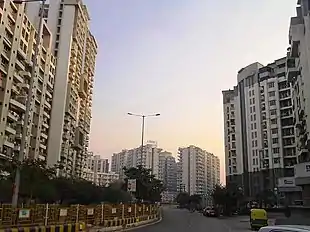 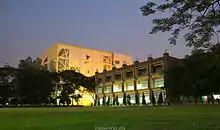    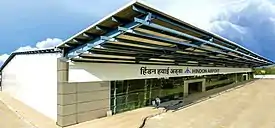 Clockwise from Top: Indirapuram Skyline, Shipra Mall, Clock House, Hindon Airport, Kaushambi Skyline and Institute of Management Technology | |
| Nickname(s): Gateway of Uttar Pradesh | |
 Ghaziabad  Ghaziabad 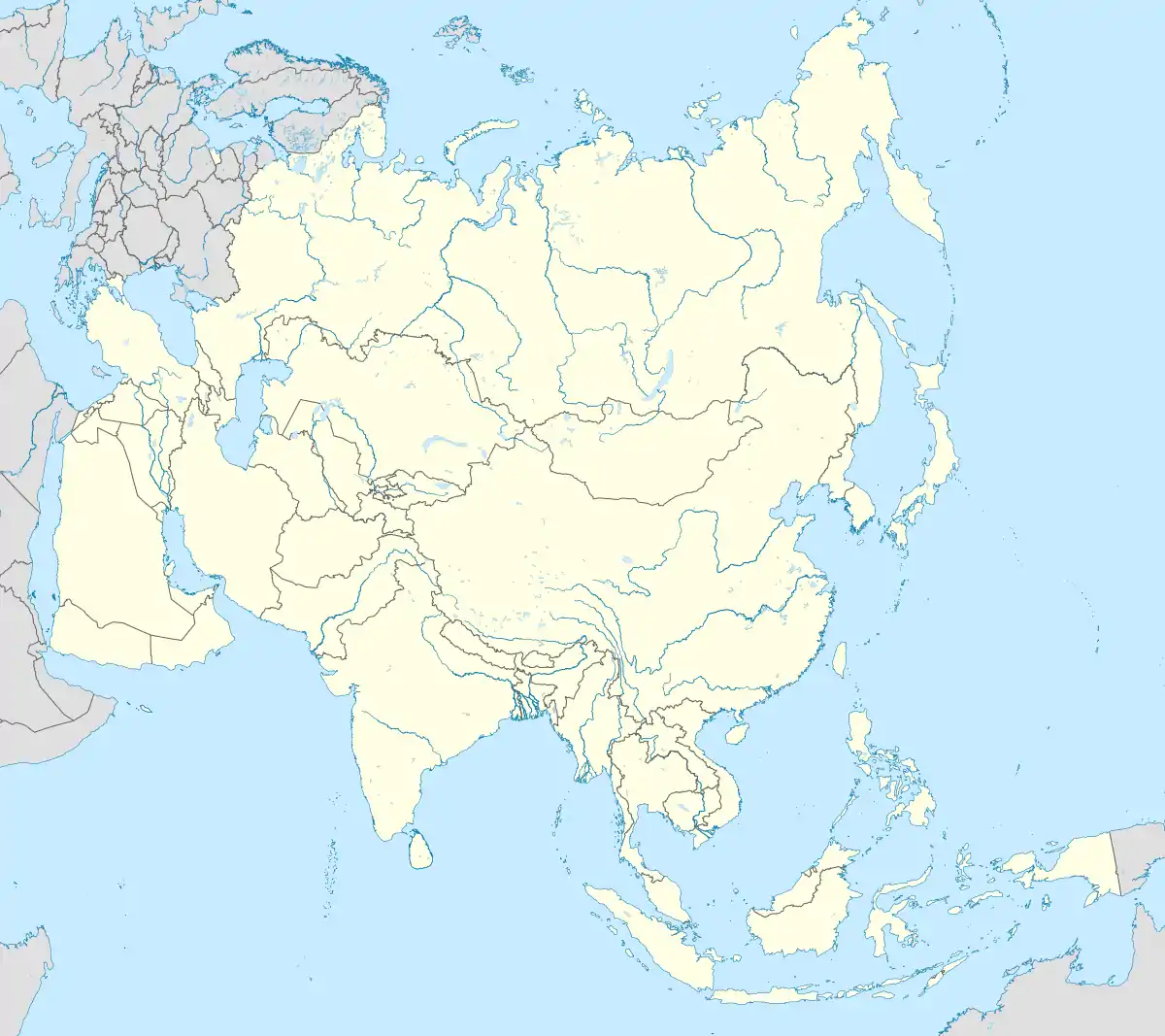 Ghaziabad | |
| Coordinates: 28.67°N 77.42°E | |
| Country | India |
| State | Uttar Pradesh |
| District | Ghaziabad |
| Founded by | Wazir Ghazi-ud-Din |
| Government | |
| • Body | Municipal Corporation |
| • Mayor, Municipal Commissioner | Asha Sharma (BJP), Dinesh Chandra |
| Area | |
| • Total | 210 km2 (80 sq mi) |
| Elevation | 214 m (702 ft) |
| Population (2011 census provisional data)[1] | |
| • Total | 1,729,000 |
| • Density | 8,200/km2 (21,000/sq mi) |
| Demonym(s) | Ghaziabadi |
| Languages | |
| • Official | Hindi |
| Time zone | UTC+5:30 (IST) |
| PIN | 201 XXX |
| Telephone code | 91-120 |
| Vehicle registration | UP-14 |
| Website | ghaziabad |
History
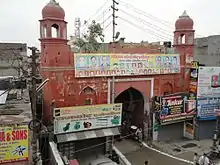
The city of Ghaziabad was founded in 1740 A.D. by Ghazi-ud-Din, who served as a wazir in the court of Mughal emperor Muhammad Shah, and named it as "Ghaziuddinnagar" after his own name.[10] The name "Ghaziuddinnagar" was shortened to its present form, i.e. "Ghaziabad" with the opening of the Railways in 1864.[11][12][13][14] During the Mughal period, Ghaziabad and especially the banks of the Hindon in Ghaziabad, remained a picnic spot for the Mughal royal family.[12]
Establishment of the Scientific Society here, during the same period is considered as a milestone of the educational movement launched by Syed Ahmad Khan.[15] The Sind, Punjab and Delhi Railway, connecting Delhi and Lahore, up till Ambala through Ghaziabad was opened in the same year.[16] With the completion of the Amritsar-Saharanpur-Ghaziabad line of the Sind, Punjab and Delhi Railway in 1870, Delhi was connected to Multan through Ghaziabad, and Ghaziabad became the junction of the East Indian Railway and Sind, Punjab and Delhi Railway.[17]
Ghaziabad, along with Meerut and Bulandshahr, remained one of the three Munsifis of the District, under the Meerut Civil Judgeship during most periods of the British Raj.[18]
Ghaziabad was associated with the Indian independence movement from the Indian Rebellion of 1857.[11]
Industrial growth
Although connected by railway since 1865, it was not until 1940 that the first modern industry appeared in Ghaziabad. However, it was in the post-independence period that industry really expanded, with a further 22 factories opening in the four years after 1947. This development can be attributed to the influx of people from the newly formed Pakistan and the relocation of businesses from what was now the Pakistani province of Punjab.[19] John Oakey and Mohan Ltd., one of India's largest concerns manufacturing coated and bonded abrasives, and originally functioning under the name of 'National Abrasives' at Rawalpindi was shifted here under the proprietorship of 'Dyer Meakins' in 1947.[20] Subsequently, the Mohan Meakin breweries were also set up in the year 1949.[21] This period also saw the development of Ghaziabad as one of India's most famous centres of the Oil Engines industry.[22]
In 1967, the municipal limits were extended up to the Delhi-UP border. Starting in the early 1970s, many steel-manufacturing units also came up in the city making it one of the primary industries of the city. This period also saw the emergence of the Electronics industry, with the setting up of Bharat Electronics Limited and Central Electronics Limited[23] Over the years, planned Industrial development saw participation from major industrial houses of the country including Mohans (Mohan Nagar Industrial Estate, 1949), Tatas (Tata Oil Mills), Modis (Modinagar, 1933; International Tobacco Co. 1967), Shri Rams (Shri Ram Pistons, 1964), Jaipurias etc. and also significant participation through foreign capital in concerns such as Danfoss India Ltd. (estd. 1968); Indo- Bulgar Food Ltd. and International Tobacco Company (estd. 1967).[24]
Demographics
Population
The provisional data derived from the 2011 census shows that Ghaziabad urban agglomeration had a population of 2,358,525, of which males were 1,256,783 and females were 1,101,742. The literacy rate was 93.81%.[25] Ghaziabad is a subcategory B1 district of category B i.e. having socioeconomic parameters below the national average.[26] It is the second largest industrial city in Uttar Pradesh after Kanpur.[27]
Religion
Hinduism is the most popular religion in Ghaziabad with 72.93% followers, followed by 25.35% Muslim followers, 0.41 Christian followers, and 0.49% Sikh followers who make up the smallest percentage of followers in the city. There are around 0.07 Buddhists, 0.35% Jain followers who are minorities. There are many religious sites in Ghaziabad such as the ISKCON Temple for Hindus, Jama Masjid for Muslims, Holy Trinity Church for Christians, and Shri Guru Singh Sabha Gurudwara for Sikhs.
Climate
As it is connected to the national capital, its temperature and rainfall are similar to Delhi. Rajasthan's dust storms and snowfall in the Himalayas and Kumaon hills name their impact in the weather regularly. The monsoon arrives in the district at the end of June or the first week of July and normally it rains until October. As in other districts of northern India mainly three seasons - summer, winter and rainy - prevail here, but sometimes due to severe snowfall in the Himalayas and Kumaon Hills, adverse weather can also be seen. Due to a number of construction and highway projects causing cutting down hundreds of old trees rapidly, the pollution and rising temperature issues have increased significantly.
Government and politics
Ghaziabad city is governed by the Ghaziabad Municipal Corporation under the Uttar Pradesh Municipal Corporation Act, 1959.[28] Ghaziabad city is spread over 210 sq. km of municipal area.[29] It upgraded from a Municipal Board to a Municipal Corporation on 31 August 1994, following the 74th Constitutional Amendment Act.[29] Ghaziabad Municipal Corporation (or Nagar Nigam Ghaziabad) is divided into 5 zones - City Zone, Kavi Nagar Zone, Vijay Nagar Zone, Mohan Nagar Zone and Vasundhara Zone.[3] The Municipal Corporation comprises 100 wards, with councillors elected from each ward.[1][30] The local elections to all wards was last held in 2017.[31] The executive head is Dinesh Chandra, the current Municipal Commissioner[32] while the elected head is the Mayor, Asha Sharma from the BJP.[33]
The municipality has the following departments: Swachh Bharat Mission, Public Works Dept, I.T Dept, Property Tax Dept, Health Dept, Street Light Dept, Water Works Dept, Law, Garden/Horticulture.[34] It has an executive committee composed of businessmen.[35]
Representation in state assembly
The city is represented in the Lok Sabha through one MP elected from the Lok Sabha constituency represented by Vijay Kumar Singh from the BJP,[36] and one MLA elected from the Vidhan Sabha constituency, represented by BJP's Atul Garg elected in 2017.[37]
Civic utilities
Nagar Nigam Ghaziabad looks after the civic activities of the city. Other development agencies of the city include the Ghaziabad Development Authority, and the UP Jal Nigam. The master plan for the city is laid by the Town & Country Planning Department, Uttar Pradesh, which is department under the Department of Housing and Urban Planning for the state.[40]
The corporation supplies water and has nearly 2.35 lakh water connections, supplying nearly 388 MLD of water per day.[41] The city also receives water from the Ganga through 50 cusec (one cubic foot of water flow per second which translates into 28.32 litres) and 100 cusec plants[41] but a lot of areas in the city constituting multi-storied apartments do not receive Ganga water and rely on groundwater.[42] Treated water is supplied to only 36.2% of households.[43]
The municipality, as well as UP Jal Nigam sets up sewage treatment plants and water treatment plants for the city.[42] The Ghaziabad Development Authority is responsible for laying networks of sewer lines and piped drinking water supply.[43] Drinking water remains a concern with 55.6% of households accessing it from tube wells, bore wells and hand pumps.[43] Only 30.5% households are connected to piped sewer lines.[43]
As of 2019, Ghaziabad generates 1,000 metric tonnes of waste daily, some of which is sent to Meerut, while 300 metric tonnes are sent to Pilkhuwa, while almost 200 metric tons is used in various GMC owned parks to create compost.[44] The corporation also dumps garbage in Indirapuram landfill site, and would dump it in Pratap Vihar landfill till they stopped on the orders of a National Green Tribunal committee.[44] The corporation also announced in September 2020 that it was creating 10 'garbage factories[45]' as a permanent solution to the city's waste problem.
Transport
Road
A proposal has been made to widen National Highway 24 (NH-24) from four to fourteen lanes on the stretch between the Ghaziabad-Delhi border and Dasna. Many residential and commercial projects are being built along the highway.[46]
Rail
The city receives Indian Railways service at Ghaziabad Junction Railway Station.
The Delhi Metro Red Line serves Ghaziabad, with eight stations. The Red Line's eastern terminus, Shaheed Sthal metro station, is located in this city. Other stations include Hindon River Station which serves Raj Nagar Extension and Mohan Nagar Station. Another station exists at Vaishali, which serves that area as well as Vasundhara and Indirapuram, and there is also a station at Kaushambi.[47]
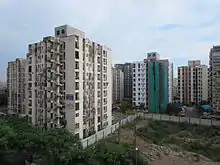
Air
Hindon Domestic Airport is the airport serving Ghaziabad which will begin operation in October 2019. The closest international airport is the Indira Gandhi International Airport. Hindon Domestic Airport currently only goes to Pithoragarh, Uttarakhand and Hubli, Karnataka.[48]
Sports
The Jawaharlal Nehru Stadium is a Cricket stadium in Ghaziabad and Mahamaya Sports stadium is multi-purpose Sports Stadium in the City.
An International Cricket Stadium is under construction at Raj Nagar Extension and will be completed by 2021.
Institutes
- ABES Engineering College
- Ajay Kumar Garg Engineering College
- IMS Engineering College
- Institute of Management Technology
- Jaipuria Institute of Management, Indirapuram Ghaziabad[49]
- Krishna Engineering College[50]
- Krishna Institute of Engineering and Technology[51]
- Raj Kumar Goel Institute of Technology[52]
- Santosh Medical College
- SRM Institute of Science and Technology (Delhi-NCR Campus)
- Sunder Deep Group of Institutions
Notable people
Arts, entertainment and television
- Lara Dutta, Miss Universe 2000 and Bollywood actress.[53]
- Pradeep Nagar, Bollywood actor[54]
Business
- Nikesh Arora, businessman, former president and COO of SoftBank Corp. and CEO of SoftBank Internet and Media, Inc.[55]
- Kapil Mohan, businessman [56]
Politics and government
- Suresh Bansal, politician[57]
- Madan Bhaiya, politician,[58]
- Roop Chaudhary, politician.[59]
- Rama Pilot, politician.[60]
- Ram Chandra Vikal, freedom fighter and Deputy chief minister of UP.[61]
Sports
- Rajkumar Baisla,Dhayanchand Awardee 2011 (Wrestling)[62][63]
- Suresh Raina, Indian Cricketer[64]
References
- "Ghaziabad Information".
- "National Capital Region- Constituent Areas". NCRPB. Archived from the original on 7 May 2015. Retrieved 1 June 2015.
- "Zone-division of Ghaziabad Nagar Nigam".
- Athique and Hill, Adrian and Douglas (17 December 2009). The Multiplex in India: A Cultural Economy of Urban Leisure (2010 ed.). New York. pp. 110–114. ISBN 9781135181888.
- "District and Sessions Court Ghaziabad- History". NIC. Archived from the original on 4 June 2013. Retrieved 27 July 2013.
- "Ghaziabad-Gateway of U.P". Ghaziabad.nic.in. Archived from the original on 28 July 2015. Retrieved 29 July 2015.
- "Business". 17 November 2011. Archived from the original on 20 November 2011.
- Ghaziabad was first listed in early 2010 as # 420 by size. "The largest cities in the world and their mayors: Cities ranked 301 to 450". City Mayors. Archived from the original on 9 March 2010., current listings: "World's fastest growing urban areas (1)". City Mayors. Archived from the original on 25 November 2010. Retrieved 1 November 2010.
- "Ghaziabad Nagar Nigam: About Us". Archived from the original on 1 February 2013.
- Anu Kapur, p. 83-85, Mapping Place Names of India
- "history1". nagarnigamghaziabad.com. Archived from the original on 2 October 2015. Retrieved 14 September 2015.
- Roy, Debashish (14 August 2011). "Ghaziabad has a long way to go to become a part of NCR backbone". The Hindu. Archived from the original on 20 July 2014. Retrieved 12 June 2014.
- "[IRFCA] Indian Railways FAQ: IR History: Early Days - 1". Irfca.org. Archived from the original on 7 March 2005. Retrieved 17 June 2014.
- "History". ghaziabad.nic.in. District Administration, Ghaziabad. Archived from the original on 8 December 2008. Retrieved 5 November 2008.
- Azimabadi, Badr (2007). Great Personalities in Islam. Daryaganj, Delhi: Adam Publishers. p. 218. ISBN 9788174351227.
- "[IRFCA] Indian Railways FAQ: IR History: Early Days - 1". Irfca.org. Archived from the original on 22 September 2014. Retrieved 17 June 2014.
- "[IRFCA] Indian Railways FAQ: IR History: Early Days - 2". Irfca.org. Archived from the original on 11 June 2014. Retrieved 17 June 2014.
- Statistical, descriptive and historical account of the North-western ... - North-western provinces - Google Books. 8 June 2007. Retrieved 17 June 2014.
- Saxena, Aruna (1989). Perspectives in industrial geography : a case study of an industrial city of Uttar Pradesh. New Delhi: Concept Pub. Co. pp. 30, 92, 98. ISBN 8170222508.
- Saxena, Aruna (1989). Perspectives in industrial geography : a case study of an industrial city of Uttar Pradesh. New Delhi: Concept Pub. Co. p. 172. ISBN 8170222508.
- "Mohan Meakin Group". Mohanmeakin.com. Retrieved 17 June 2014.
- Saxena, Aruna (1989). Perspectives in industrial geography : a case study of an industrial city of Uttar Pradesh. New Delhi: Concept Pub. Co. p. 92. ISBN 8170222508.
- Saxena, Aruna (1989). Perspectives in industrial geography : a case study of an industrial city of Uttar Pradesh. New Delhi: Concept Pub. Co. pp. 97, 98. ISBN 8170222508.
- Saxena, Aruna (1989). Perspectives in industrial geography : a case study of an industrial city of Uttar Pradesh. New Delhi: Concept Pub. Co. pp. 124, 93, 11, 39, 69. ISBN 8170222508.
- "Urban Agglomerations/Cities having population 1 lakh and above" (PDF). Provisional Population Totals, Census of India 2011. Archived (PDF) from the original on 2 April 2013. Retrieved 7 July 2012.
- "Meeting of Empowered Committee" (PDF). Minutes of the Meeting Report. Government of India. Archived from the original (PDF) on 30 September 2011. Retrieved 18 March 2013.
- "district and session court-ghaziabad". Ghaziabad.nic.in. Archived from the original on 14 February 2014. Retrieved 17 June 2014.
- "The role of female human resource for regional development a case study of kanpur metropolis".
- "Ghaziabad City". ghaziabadnagarnigam.in. Retrieved 26 August 2020.
- "Parshad List". ghaziabadnagarnigam.in. Retrieved 29 October 2020.
- Desk, India com News (25 November 2017). "Ghaziabad Nagar Nigam Polls 2017: Ward-Wise Candidate and Municipal Corporation Details of Ghaziabad, UP". India News, Breaking News, Entertainment News | India.com. Retrieved 26 August 2020.
- Feb 18, Abhijay Jha / TNN /; 2019; Ist, 21:45. "GMC: Dinesh Chandra is GMC's new municipal commissioner | Ghaziabad News - Times of India". The Times of India. Retrieved 26 August 2020.CS1 maint: numeric names: authors list (link)
- Dec 12, Ayaskant Das / TNN / Updated; 2017; Ist, 19:14. "BJP leader Asha Sharma sworn in as new Ghaziabad mayor | Noida News - Times of India". The Times of India. Retrieved 26 August 2020.CS1 maint: numeric names: authors list (link)
- "Nagar Nigam Ghaziabad Official Website". ghaziabadnagarnigam.in. Retrieved 29 October 2020.
- "Organization|GMA- Ghaziabad Management Association". gmaindia.org. Retrieved 29 October 2020.
- "Vijay Kumar Singh(Bharatiya Janata Party(BJP)):Constituency- GHAZIABAD(UTTAR PRADESH) - Affidavit Information of Candidate". myneta.info. Retrieved 23 September 2020.
- "Atul Garg(Bharatiya Janata Party(BJP)):Constituency- GHAZIABAD(GHAZIABAD) - Affidavit Information of Candidate". myneta.info. Retrieved 23 September 2020.
- "Commissionerate: New police system in Ghaziabad, Varanasi, Kanpur likely". The Indian Express. 15 January 2020. Retrieved 29 October 2020.
- "Who's Who | District Ghaziabad, Government of Uttar Pradesh | India". Retrieved 29 October 2020.
- "Official Website of Town And Country Planning Department, Uttar Pradesh, India. / About Us / Profile". uptownplanning.gov.in. Retrieved 26 August 2020.
- "Ghaziabad's residential areas to get water ATMs before summer". Hindustan Times. 9 January 2017. Retrieved 26 August 2020.
- "Ghaziabad: New Ganga water treatment plant to tackle city's water scarcity". www.cityspidey.com. Retrieved 26 August 2020.
- Sep 4, TNN /; 2015; Ist, 03:08. "Treated water doesn't reach over half of Ghaziabad homes | Noida News - Times of India". The Times of India. Retrieved 26 August 2020.CS1 maint: numeric names: authors list (link)
- Jan 25, Abhijay Jha / TNN /; 2019; Ist, 10:28. "Meerut allows Ghaziabad to dump 200 tonnes of waste daily | Ghaziabad News - Times of India". The Times of India. Retrieved 8 September 2020.CS1 maint: numeric names: authors list (link)
- Pioneer, The. "GZB Municipal corp to set up 10 garbage factories". The Pioneer. Retrieved 8 September 2020.
- "Make NH-24 eight-lane to ease mess: Akhilesh Yadav". Hindustan Times. Archived from the original on 4 June 2013. Retrieved 20 June 2013.
- "Ghaziabad boards Metro for first traffic-free ride to work". The Indian Express. 15 July 2011. Retrieved 16 April 2013.
- UDAN flights from Hindon airport, Ghaziabad, will connect to Hubli, Jamnagar, Shimla, Kalburgi, Kannur, Nashik, Faizabad, Pithoragarh Livemint
- Jaipuria Institute of Management
- Krishna Engineering College
- https://www.kiet.edu/
- https://rkgit.edu.in/
- "Happy Birthday Lara Dutta: Her top moments". The Indian Express. 16 April 2015. Archived from the original on 10 January 2018. Retrieved 10 January 2018.
- "Archived copy". Archived from the original on 16 June 2016. Retrieved 18 May 2016.CS1 maint: archived copy as title (link)
- "Google's Nikesh Arora: Man with a plan". Live Mint. Archived from the original on 10 January 2018.
- Thomas, Maria. "Old Monk's old man is no more". Quartz. Archived from the original on 10 January 2018. Retrieved 10 January 2018.
- "Archived copy". Archived from the original on 16 August 2018. Retrieved 15 August 2018.CS1 maint: archived copy as title (link)
- "Archived copy". Archived from the original on 7 August 2018. Retrieved 15 August 2018.CS1 maint: archived copy as title (link)
- "Archived copy". Archived from the original on 7 August 2018. Retrieved 15 August 2018.CS1 maint: archived copy as title (link)
- "Members Bioprofile: Pilot, Smt. Rama". Lok Sabha. Archived from the original on 7 November 2017. Retrieved 4 November 2017.
- "Archived copy". Archived from the original on 17 February 2013. Retrieved 8 September 2018.CS1 maint: archived copy as title (link)
- https://m.jagran.com/uttar-pradesh/ghaziabad-8589007.html
- http://www.yespunjab.com/info4u/item/48743-list-of-dhyan-chand-award-recipients-india-s-highest-award-for-lifetime-achievement-in-sports-and-games
- "Suresh Raina Profile - ICC Ranking, Age, Career Info & Stats". Cricbuzz. Archived from the original on 3 July 2017. Retrieved 10 January 2018.
Further reading
- "Real Estate". Jasmine Grove. Retrieved 24 April 2020.
- "Census of India 2011 – Provisional Population Totals | Uttar Pradesh Series 10" (PDF). 20 April 2011. Retrieved 14 September 2015.
- "Ghaziabad boards Metro for first traffic-free ride to work - Indian Express". indianexpress. Retrieved 14 September 2015.
- "Ghaziabad Art & Culture". goghaziabad.com. Retrieved 14 September 2015.
External links
| Wikimedia Commons has media related to Ghaziabad. |
- Ghaziabad District Administration
 Ghaziabad travel guide from Wikivoyage
Ghaziabad travel guide from Wikivoyage
